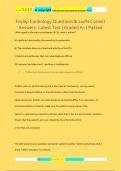Exam (elaborations)
Fisdap Cardiology Questions & 100% Correct Answers- Latest Test | Graded A+ | Passed
- Course
- Institution
With regard to the electrocardiogram (ECG), what is artifact? A) significant abnormality discovered by the paramedic B) The complete absence of electrical activity on the ECG C) Electrical interference that can make diagnosis difficult D) Improper lead placement, resulting in misdiagnosis -:-...
[Show more]



